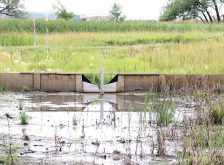As spring approaches, the agricultural community is becoming increasingly concerned about potential forecasts of drought across the southern Prairies. And rightly so; the print and electronic media have posted numerous drought-related articles.
Wide areas of southern Alberta and southwestern Saskatchewan and their dryland farms, irrigated farms and ranching areas could be affected. But what helpful information has been extended to farmers and ranchers about drought preparedness?
Both Alberta Agriculture and Saskatchewan Agriculture do have drought plans. For the Saskatchewan plan, go to the province’s drought preparedness web page, or the plan can be downloaded directly. On the Alberta Agriculture drought page, items available for download include a report titled “Alberta Agriculture Drought and Excess Moisture Plan.”
Read Also

Cancer agency reclassifies another herbicide ‘probably carcinogenic’
The WHO’s cancer research agency has now put atrazine, a herbicide well known to corn growers, in the same potential-hazard category where the agency put glyphosate.
The Alberta plan was published in May 2016. It has not been updated in eight years! This isn’t surprising, as most extension and research staff who drafted the plan were terminated four years ago.
Some key points in the Alberta plan:
- Form partnerships with the agricultural community, seed plants and others to promote water conservation and drought management.
- Select appropriate crop types and varieties, herbicides, pesticides and fertilizers; make appropriate decisions about timing of planting/harvest, and infrastructure choices like type of machinery and buildings.
- Provide technical and financial assistance to secure water supplies or increase water use efficiency through various programs.
- Although parameters of highest importance are yield and quality, testing of new cereal plant materials should include assessment of genetic traits that reflect tolerance to drought, pests, flooding, disease, and water use efficiency.
Alberta’s eight-year-old plan had good intentions, but for Alberta farmers and ranchers, it was all talk and not much action. No partnerships have been developed. Not much packaged information was put together. Agronomic recommendations on crops, varieties et cetera have not been developed or compiled. Research and testing of crops for drought tolerance, et cetera has not been undertaken. Why? Almost all research and extension staff who would have done this were terminated by former agriculture minister Dreeshen.
What can farmers do to plan and prepare for drought?
Farmers in the more drought-prone southern Prairies should consider developing drought management preparedness plans specifically for their farms. Unfortunately, neither the Alberta nor Saskatchewan Agriculture drought management plans explain how farmers could work through this challenging process.
Fortunately, other agencies have given this a lot of thought and attention. One excellent example is the Colorado Agricultural Drought Handbook, developed by Colorado State University Extension and available online. This is an excellent manual that is worth the time to read and glean information. Colorado has much different conditions than the southern Canadian Prairies but much of the outline on planning and preparation offers useful direction. This type of detailed information should be available for Prairie farmers in Western Canada.
Briefly, the Colorado process involves several steps. Start by assessing your operation and resources. First, how have past droughts have impacted the various aspects of your operation? Identify actions that could be taken to reduce effects of future droughts. The Colorado Handbook has inventory worksheets to assist with working through this process. Focus on areas of your operation with ideas for strategies and actions. It recommends focusing on assessment first. Then, work on developing your plan:
- Define the drought preparedness goals for your operation.
- Determine critical times or conditions for making decisions.
- Identify the various strategies to reduce your risk.
- Use scenarios to prioritize strategies.
Then, implement your plan. After each dry year, adapt your plan based on what your experiences were and what you learned.
Irrigation farmers should carefully monitor irrigation district information updates. The St. Mary River Irrigation District in southern Alberta in March already advised water users of a preliminary allocation of only eight inches (20 cm) of water per acre, compared to the normal 18 inches (45 cm). If your district advises of restrictions on irrigation water, develop irrigation water management scenarios and be prepared in spring and summer to track your irrigation water during the growing season. This will allow you to make informed plans to reallocate irrigation water to ensure optimum crop production across the farm. (See my article, Managing Irrigation With Limited Water, in the March 5, 2024 issue on page 19.)
As for drought planning and preparedness for ranchers, there is an excellent publication online titled Managing Drought Risk on the Ranch: A Planning Guide for Great Plains Ranchers. It was developed for U.S. ranchers in the northern Great Plains but is an excellent resource Prairie ranchers can consult to assist with drought management planning.
These are just some of my thoughts on preparedness for drought and some resources to assist you; see below. Consider developing a drought management and preparedness plan for your operation.
I sincerely hope pending forecasts of drought this spring and summer do not come to pass, but being prepared and having plans in place can go a long way to reduce your risk and stress. Here’s hoping for a very good spring!
Strategies to consider
For both irrigation and dryland operations, here are points to assist with developing a drought management plan.
- Learn how to check and assess soil moisture in your fields, using a one-inch diameter soil auger and the “hand-feel” method. Develop a good understanding of the amounts of water the soils in your fields will hold. Become familiar with the field capacity and wilting point moisture levels in your fields.
- Frequently and regularly monitor soil moisture conditions in your fields down to 40 inches (100 cm) using a Dutch auger and feeling the soil, or use soil moisture sensors.
- Carefully watch long-range and seasonal weather/climate forecasts for precipitation and temperature to plan farm management. Stay up to date on current forecasts and potential impacts to your operation.
- Be flexible to shift toward more efficient water-using crops and varieties. Spring wheat, barley, mustard, flax, peas and most winter cereals are somewhat more drought-tolerant but none of our commonly grown Prairie crops are drought-resistant. Much more western Canadian research is needed in these areas.
- Most farmers already use no-till or conservation tillage systems to minimize soil disturbance, so as to minimize soil moisture evaporation and loss. This is an excellent conservation practice.
- Maintain standing stubble over winter to aid in snow trapping and preventing soil erosion. Soil erosion reduces soil quality, reduces water infiltration into soil and reduces water holding capacity.
- Ensure crop residue is maintained on the soil surface, to reduce evaporation from surface soil and increase water infiltration into soil.
- Include a number of different crops in your crop rotation for increased diversity.
- In drier-than-normal springs, consider decreasing seeding rates to reduce plant populations for dry conditions.
- Seed frost-tolerant crops such as wheat, barley, and pea as early as reasonable in the spring to increase water use efficiency.
- In drier springs, consider reducing fertilizer inputs proportionally to the level of pending drought and poorer spring soil moisture conditions.
- Be sure to follow 4R fertilizer management (right amount, right place, right time, right source) based on your target yields. There is no point in overfertilizing or using unnecessary fertilizers in a drier-than-normal spring.
- Keep tillage to a minimum. When soils are moist, one tillage operation can result in up to 0.5 to one inch (12-25 mm) of moisture loss, depending on soil moisture level and level of soil disturbance.
- Purchase adequate crop insurance to reduce risk in drought years.
















